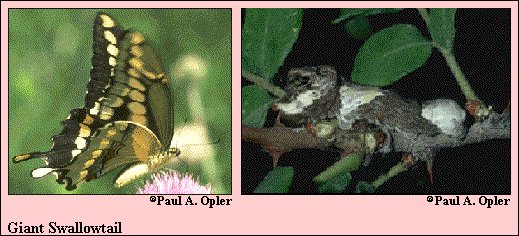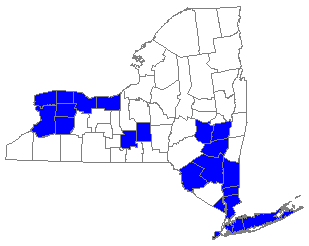 |
 

 |



Giant Swallowtail (Papilio cresphontes Cramer)
Wing span: 4 - 6 1/4 inches (10.2 - 16 cm).
Identification: Forewing with diagonal band of yellow spots. Tails are edged with black and filled with yellow.
Life history: Males patrol for receptive females. Females lay single eggs on host leaves and twigs. Caterpillars resemble bird droppings and eat leaves and young shoots. Chrysalids hibernate.
Flight: Two in the north from May-September; all year in Florida and the Deep South.
Caterpillar hosts: Trees and herbs of the citrus family (Rutaceae) including Citrus species, prickly ash (Zanthoxylum americanum), and hop tree (Ptelea trifoliata).
Adult food: Nectar from lantana, azalea, bougainvilla, bouncing Bet, dame's rocket, goldenrod, Japanese honeysuckle, and swamp milkweed.
Habitat: Many locales including rocky and sandy hillsides near streams or gullies in the north; pine flats, towns, and citrus groves in the south.
Range: Throughout eastern North America west to the Rocky Mountains, south through the desert Southwest to South America. A rare stray to Quebec, North Dakota, and Bermuda.
Conservation: Not required in the United States.
Management needs: Caterpillars ("orange dogs") are occasional pests of citrus.
The Nature Conservancy Global Rank: G5 - Demonstrably secure globally, though it may be quite rare in parts of its range, especially at the periphery.
References:
Opler, P. A. and G. O. Krizek. 1984. Butterflies east of the Great Plains.
Johns Hopkins University Press, Baltimore. 294 pages, 54 color plates.
Opler, P. A. and V. Malikul. 1992. A field guide to eastern butterflies.
Peterson field guide #4. Houghton-Mifflin Co., Boston. 396 pages, 48
color plates.
Scott, J. A. 1986. The butterflies of North America. Stanford University Press,
Stanford, Calif. 583 pages, 64 color plates.
Author: Jane M. Struttmann
State and Regional References:
Cech, R. 1993. A Distributional Checklist of the Butterflies and Skippers of
the New York City Area (50-mile Radius) and Long Island. New York City
Butterfly Club Special Publication. 27 pp.
Forbes, W.T.M. 1960. Lepidoptera of New York and Neighboring States. Part
IV: Agaristidae through Nymphalidae Including Butterflies. Cornell Univ.
Agricultural Experimental Station, Ithaca, N.Y. Memoir 371. 188 pp.
Glassberg, J. 1993. Butterflies Through Binoculars: A Field Guide to
Butterflies in the Boston-New York-Washington Region. Oxford Univ. Press,
New York, N.Y. 160 pp.
Klass, C. and Dirig, R. 1992. Learning about Butterflies. Cornell Cooperative
Extension Publication, 4-H Member/Leader Guide 139-M-9. Ithaca, N.Y.
36 pp.
Layberry, R.A., Hall, P.W. & Lafontaine, D.J., 1998. The Butterflies of
Canada. University of Toronto Press, Toronto, ON. 280 pp.
Opler, P.A. 1998. A field guide to eastern butterflies, revised format.
Houghton Mifflin Co., Boston.
Shapiro, A.M. 1974. Butterflies and Skippers of New York State. Cornell Univ.
Agricultural Experimental Station, Ithaca, N.Y. Search 4:1-60.

